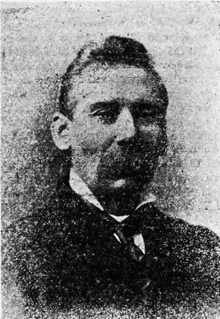
Vernon Hartshorn was a Welsh trade unionist and Labour Party politician who served as a Member of Parliament (MP) from 1918 until his death.

Rhondda, or the Rhondda Valley, is a former coalmining area in South Wales, historically in the county of Glamorgan. It takes its name from the River Rhondda, and embraces two valleys – the larger Rhondda Fawr valley and the smaller Rhondda Fach valley – so that the singular "Rhondda Valley" and the plural are both commonly used. The area forms part of the South Wales Valleys. From 1897 until 1996 there was a local government district of Rhondda. The former district at its abolition comprised sixteen communities. Since 1996 these sixteen communities of the Rhondda have been part of Rhondda Cynon Taf County Borough. The area of the former district is still used as the Rhondda Senedd constituency and Westminster constituency, having an estimated population in 2020 of 69,506. It is most noted for its historical coalmining industry, which peaked between 1840 and 1925. The valleys produced a strong Nonconformist movement manifest in the Baptist chapels that moulded Rhondda values in the 19th and early 20th centuries. It is also known for its male voice choirs and in sport and politics.

The Miners Strike of 1910-11 was an attempt by miners and their families to improve wages and living conditions in severely deprived parts of South Wales, where wages had been kept deliberately low for many years by a cartel of mine owners.

William Brace was a Welsh trade unionist and Liberal and Labour politician.

William Abraham, universally known by his bardic name, Mabon, was a Welsh trade unionist and Liberal/Labour politician, and a member of parliament (MP) from 1885 to 1920. Although an MP for 35 years, it was as a trade unionist that Abraham is most well known. Initially a pioneer of trade unionism, who fought to enshrine the principle of workers' representation against the opposition of the coal-owners, he was regarded in later life as a moderate voice believing that disputes should be solved through conciliation rather than industrial action. This drew him into conflict with younger and more militant leaders from the 1890s onwards. Although the defeat of the miners in the Welsh coal strike of 1898 was a clear defeat for Mabon's strategy, his prestige was sufficient to ensure that he became the first president of the South Wales Miners' Federation which was established in the wake of the dispute. Abraham was noted for his powerful speaking voice, and was a renowned orator in English and Welsh.

The South Wales Miners' Federation (SWMF), nicknamed "The Fed", was a trade union for coal miners in South Wales. It survives as the South Wales Area of the National Union of Mineworkers.
Noah Ablett was a Welsh trade unionist and political theorist who is most noted for contributing to 'The Miners' Next Step', a Syndicalist treatise which Ablett described as 'scientific trade unionism.

Archibald Hood was a Scottish engineer and coalowner who became an important figure in the industrial growth of the Rhondda Valley. The son of a colliery official, Hood would make his name as a coalowner of collieries first in Scotland and later in Llwynypia in South Wales.
The Miners' Next Step was an economic and political pamphlet produced in 1912 calling for coal miners through their lodges, to embrace syndicalism and a new 'scientific' trade unionism. The pamphlet was written by the 'Unofficial Reform Committee' a group of syndicalist and socialists involved in the Plebs' League and the Cambrian Combine strike of 1910-11. The main author is recognised as Noah Ablett.
The Aberdare strike of 1857–1858 was one of the first significant industrial disputes in the history of the steam coal trade of South Wales. The origins of the strike lay in the decision of the employers to impose a wage reduction of up to 20%, as a result of the general depression in trade in the aftermath of the Crimean War. During the dispute a trade union appeared amongst the miners of the Aberdare Valley but the men were ultimately forced to return to work on the terms set by the owners.
David Morgan was a Welsh miners' agent and trade unionist who played a prominent role in the history of industrial relations in the South Wales Coalfield from the 1870s until his death in 1900.

The Monmouthshire and South Wales Coal Owners' Association (MSWCOA) was an association of mine owners in South Wales that was active between 1873 and 1955. It fought wage increases, safety regulations, unionisation and other changes that would cut into profits. It managed to link miners wages, which were based on piece-work, to the price of coal. It was involved in various labour disputes, including a lengthy strike in 1926. The coal mines became unprofitable in the 1930s and were nationalized in 1947, making the association irrelevant.
The Cambrian Miners' Association, also known as the Rhondda District Miners' Association, was an early trade union representing coal miners in the Rhondda Valley, in Wales.
The Monmouthshire and South Wales Miners' Association was a trade union representing coal miners in south eastern Wales.

Isaac Evans was a Welsh trade union leader and politician.
The Western Miners' Association was a trade union representing coal miners in parts of South Wales, centred on Neath.
The Anthracite Miners' Association was a trade union representing coal miners in parts of Carmarthenshire, Glamorgan and Breconshire, in South Wales.

Thomas Daronwy Isaac, often known simply as Daronwy, was a Welsh politician and trade unionist.
John Davies was a Welsh politician and trade unionist, who served as Mayor of Merthyr.
The Aberdare, Merthyr and Dowlais Miners' Association was a trade union representing coal miners in part of Glamorgan in South Wales.











